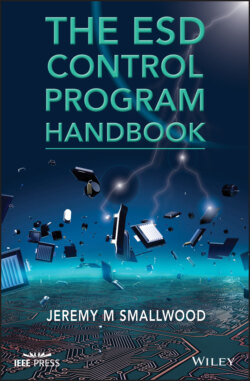Читать книгу The ESD Control Program Handbook - Jeremy M. Smallwood - Страница 30
1.5 Earthing, Grounding, and Equipotential Bonding
ОглавлениеElectrostatic discharges occur because of voltage differences between the objects between which the discharge occurs. If there were no voltage difference, then no ESD could occur.
So, one way to prevent ESD from occurring is to eliminate voltage differences between objects. If the two objects are conductors, connecting them electrically ensures that they are eventually at the same voltage. This must be so, as if any voltage difference were to arise, charge (current) would flow due to the voltage difference, until there is no voltage difference. The practice of connecting conductors together to eliminate voltage differences is known as equipotential bonding.
If two conductors at two different voltages are brought into contact, an electrostatic discharge will occur as part of the voltage equalization process. If one of the conductors is susceptible to ESD damage, it could risk being damaged as a result. So, ESD‐susceptible parts must only make contact with other conductors, including grounded conductors, in circumstances designed to protect against damage.
In many practical cases, one of the conductors concerned may already be electrically connected to an electrical earth or can be conveniently connected to earth. The earth is often defined as our 0 V reference point in electricity power distribution, electrostatics, and ESD control. So, it is often convenient and is common practice to electrically connect all conductors to earth. Earth is also known as ground, and earthing is also known as grounding.
The terms earthing and grounding can have different meanings and requirements in different contexts or industries. An electrical engineer may require an earth resistance less than an ohm. A plant engineer may earth bond two items of plant, requiring a resistance less than 10 Ω. An electromagnetic compatibility (EMC) engineer may require an extremely low impedance to be maintained from direct current (DC) to hundreds of MHz or even GHz. To an ESD control practitioner, a resistance to ground <109 Ω at dc may be sufficient.
In practice in ESD control, there are various types of ground that can be used. In the ESD standards IEC 61340‐5‐1:2016a and ANSI/ESD S20.20‐2014, the term grounding is used to mean any of the following:
Connection to electrical earth (the safety earth wire of a mains electrical system)
Connection to a functional earth (e.g. an earth rod driven into the ground)
Connection to an equipotential bonding system
